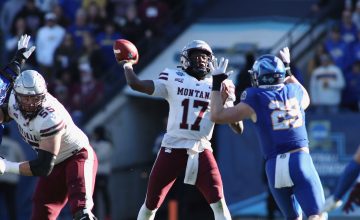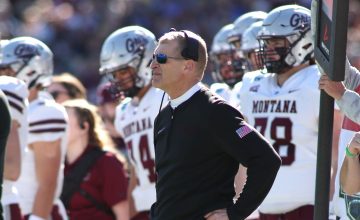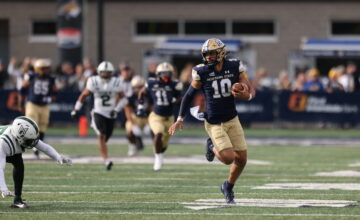Editor’s note: This is the second in a five-part series of stories coming out of Montana State’s spring football practices. The Bobcats wrapped up the five-week session with the Sonny Holland spring game on April 22. For Part I, click here
Following Montana State’s second scrimmage of the spring, Chris Murray proclaimed his goal for the final week of the five-week session was to eliminate mistakes, particularly in the red-zone.
During MSU’s final practice the day before the Sonny Holland spring game in Bozeman, Murray said the offense turned the ball over one time. The miscue came when Murray threw an interception on a pass to the end-zone intended for sophomore wide receiver Kevin Kassis.
On the final play of the Sonny Holland game, Murray called the same smash concept and targeted the explosive Kassis on a flag route once again. Murray faked a handoff to a running back, rolled smoothly to his right, planted his feet and let loose a throw with more velocity than perhaps any before during his brief career as MSU’s quarterback.
This time, instead of floating in the air and allowing the cornerback playing Cover 2 to leap and snare an under thrown ball, Murray fired a bullet to Kassis, who secured the dart for a 21-yard touchdown to help the starting Bobcat offense stamp spring drills with a crescendo.
“I don’t think Chris makes that pass last year,” Kassis said after a huge day that saw him catch four passes for 87 yards and two touchdowns, both from Murray, on April 22. “You can definitely see the footwork and all the hard work he is putting in paying off.”
The progress of Montana State’s offense was incremental during the spring but the improvements were noticeable, both in Murray’s honed fundamentals under new quarterback coach DeNarius McGhee and in MSU’s fluidity under new offensive coordinator Brian Armstrong.
“I’m definitely more confident now than I was at the start of spring practice,” MSU senior wide receiver Mitch Herbert, an All-Big Sky selection as a sophomore, said after the Sonny Holland game. “I think we’ve come a long way as an offense. And Chris is doing a great job at quarterback. As receivers, you saw what we could do today.
“To end on a high note like that gives us some momentum going into the summer.”
It’s a welcome change for an offense that struggled to manufacture points mightily last season, particularly during MSU’s six-game losing streak to begin conference play. MSU’s experiment with strong-armed transfer Tyler Bruggman, a senior-to-be who graduated and left the program a week after spring drills ended, produced inconsistent and sometimes disastrous results.
Murray took over as the full-time starter midway through the regular-season as a 17-year-old with electric running ability in the open field. But Murray performed like a gun-shy hunting dog when defenses put pressure on him, quick to run but slow to stand in the pocket with patience.
“No. 8, when he gets on the edge, he’s a problem (for defenses),” MSU second-year head coach Jeff Choate said following the Triangle Classic spring game in Great Falls. “I wouldn’t want to defend him. He’s a problem. If he can continue to evolve as a passer…if he can continue to mature as a decision-maker, he’s got a big upside.”
The hiring of McGhee — a two-time Big Sky Conference MVP who quarterbacked Montana State to three straight league titles to begin the decade — has led to a revamping of Murray’s mechanics, particularly his footwork. McGhee has also demanded Murray use poise and patience before using his breathtaking running ability. Ball security has also been a huge focus — MSU turned the ball over a staggering 23 times during its six-game losing streak.
“Well I mean of course they tell me that if nothing’s there, run, but sometimes when things are there, my feet get antsy and that tells me to run,” the ingenuous Murray said after a mid-week practice during spring ball. “If my feet are calmed down, then I have the perfect everything to actually make the throw and not just get out of the pocket just because I see some free space — actually make my reads.
“Last year I would take the three (steps) and then just chatter my feet and that would throw the timing off or I wouldn’t get enough drive and I couldn’t throw.”
In Choate’s first season, Montana State’s offense seemed fragmented with former offensive coordinator Courtney Messingham calling the plays. With Armstrong now at the controls, the play calling is more measured, partially a product of no longer having two quarterbacks to choose from.
On many occasions this spring, the Bobcat offense played with tempo, employing balanced attacks complete with multiple formations, play-action passes, misdirection, varying tempos, and play calls out of both huddles and no-huddle formats.
“Tempo this spring, we have been all no-huddle although I don’t know if I would say we are fast no huddle,” Armstrong said. “I would anticipate next fall probably us huddling more but being able to change tempo, be able to play fast and also huddle, whatever the game demands.”
With the thought that Bruggman, a former four-star recruit who spent one season each at Washington State, Louisville and Scottsdale CC before landing at Montana State, could stretch defenses with his strong arm, the MSU staff crafted an attack that would be emphasize on throwing the ball down the field. When Bruggman struggled, the play-calling became more sporadic, a downfall accentuated by players like the normally sure-handed Herbert not coming up with clutch catches like he had in the past.
When Murray took over, the playbook shrank and packages to get the quarterback along with veteran running backs Chad Newell and Gunnar Brekke simultaneously became more prevalent. Murray threw for 199 yards and three touchdowns and rushed for 131 yards in his first start against Weber State but a crucial fumble and interception were among three first-half turnovers by the Bobcats that resulted in a 42-14 halftime deficit. Against Eastern Washington, Murray scored on a 70-yard touchdown run and threw a 53-yard touchdown to Connor Sullivan but two fumbles and two picks doomed MSU in a 41-17 home loss.
The song remained the same in a 38-21 loss at Southern Utah: Murray staked MSU to a 7-0 lead with one of his 12 touchdown runs during his Big Sky Freshman of the Year season. He also threw a pair of touchdowns but was intercepted three times.
Employing its most run-heavy game plan to date, Murray finally took care of the football in MSU’s home finale against UC Davis. The Bobcats rushed for more than 250 yards and played turnover-free football to post a 27-13 victory, MSU’s first Big Sky win of 2016.
Turnover-free football and a bruising run game that piled up 378 rushing yards resulted in a 24-17 victory in Missoula to cap the season on a two-game winning streak. During spring ball, ball security was again a huge point of emphasis. Murray and the rest of the offense showed improvement as the session progressed.
“I think Coach Choate has done a good job of that, putting us in the red-zone, making us realize every down is a money down, so if you have a procedure penalty or you don’t make a good decision with the football, it hurts everybody. Not just you, not just the offense, it hurts everybody,” MSU senior left tackle Dylan Mahoney said after MSU’s Good Friday scrimmage in April.
Montana State running backs coach Michael Pitre kicked off spring ball by showing his unproven group former Seattle Seahawks running back Marshawn Lynch’s famed run against the New Orleans Saints that eared him the nickname ‘Beast Mode’.
The point was to remind the MSU running backs — a group led by senior Nick LaSane but thin in terms of experience thereafter — that, although Murray has progressed throwing the ball, a powerful run game will still be essential for MSU’s success this fall.
“We are going to pound, we are going to pound and we are going to keep pounding, run through their face and they are going to give us the yards,” LaSane said following the Sonny Holland spring game that featured a 28-yard jaunt by the 5-foot-11, 220-pounder.
“We are going in with the mentality that we are going to pound the rock.”
But the inexperience and inconsistencies of the offense, particularly the plague of turnovers thwarted winning efforts. MSU averaged 25.6 points per game, 11th in the 13-team league. MSU’s defense returns all but two players who started in the win over the Griz. That defense observed for the duration of spring the progress made by MSU’s offense.
“On offense, we have some playmakers,” MSU sophomore safety Brayden Konkol said. “Kevin (Kassis), Cam (Sutton), Justin (Paige), Mitch (Herbert), all those guys are good. Coach Armstrong was really good at calling the plays at (Rocky Mountain College where he was the head coach before coming to MSU). He has a lot of experience. They are making a huge improvement from last year, you can tell. They are getting it together and they are going to be tough.”
Photos by Brooks Nuanez. All Rights Reserved.



















